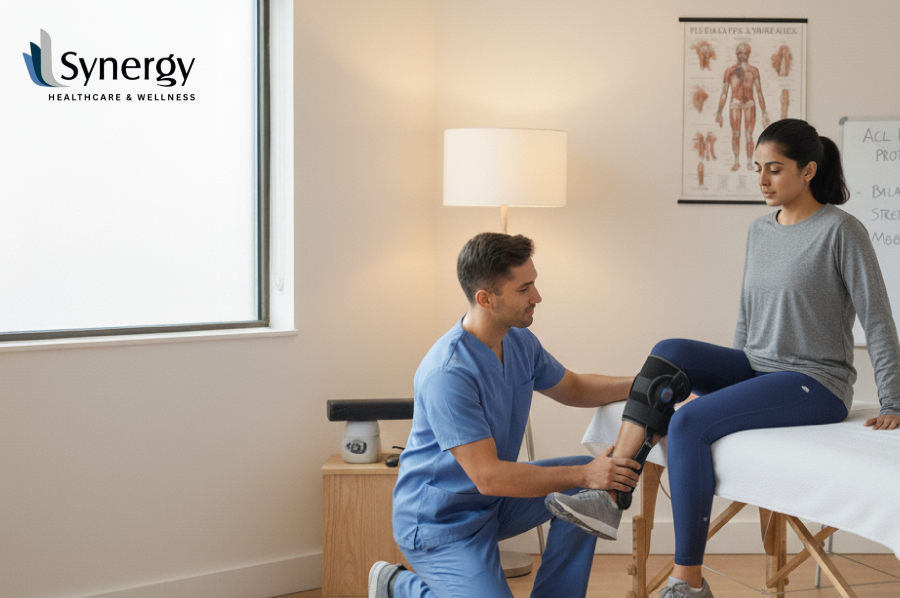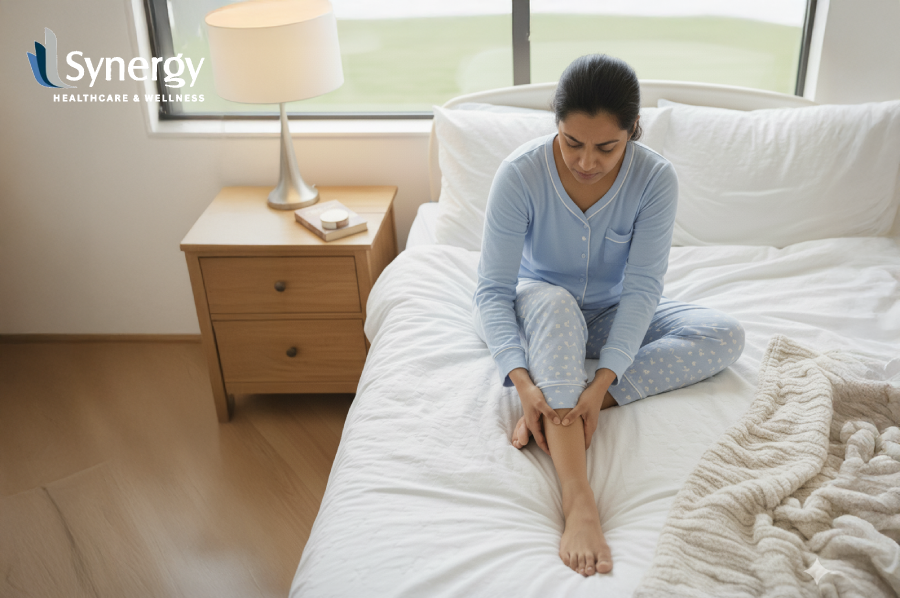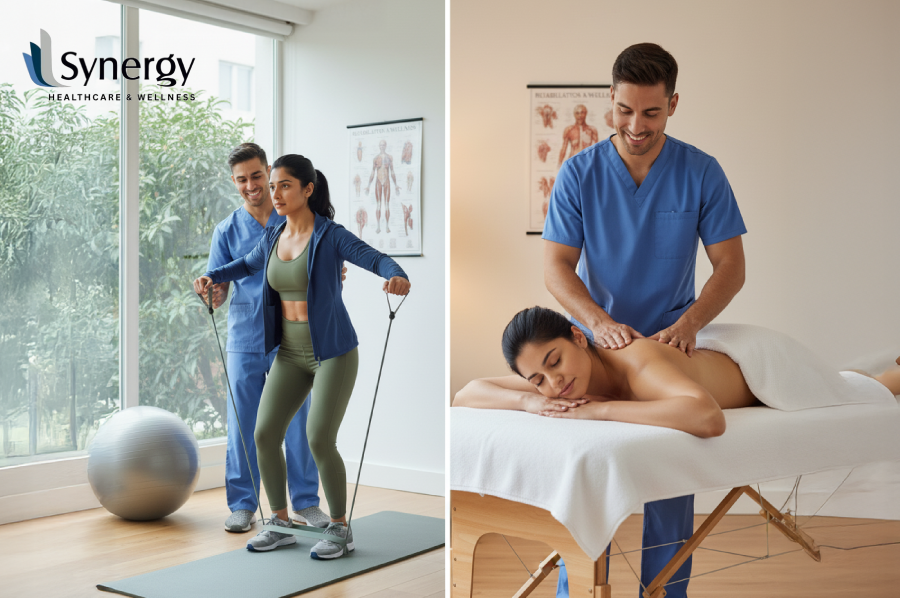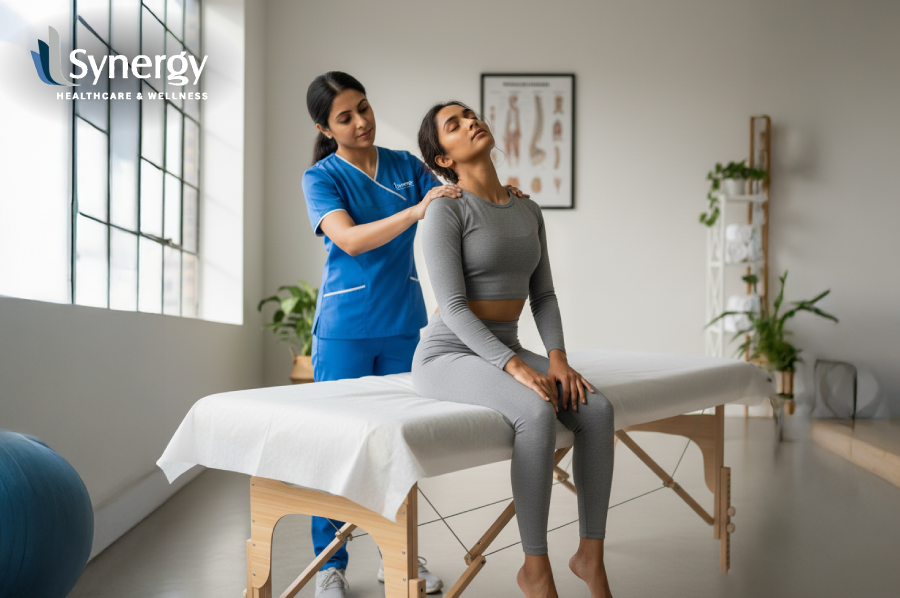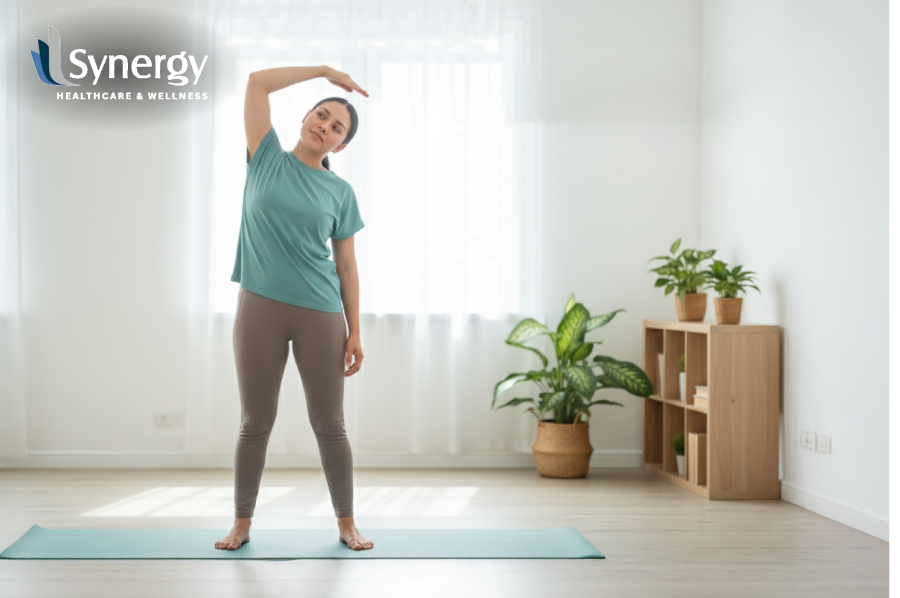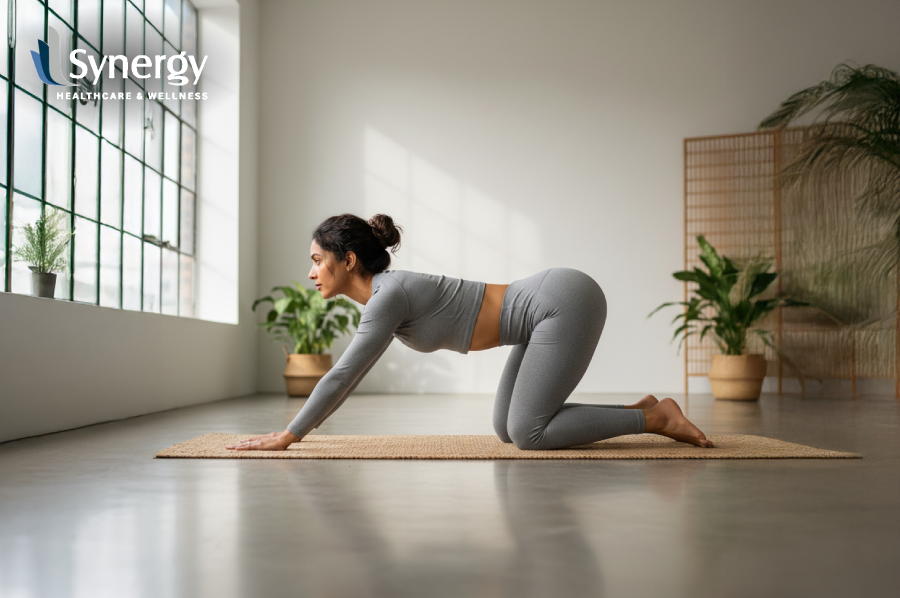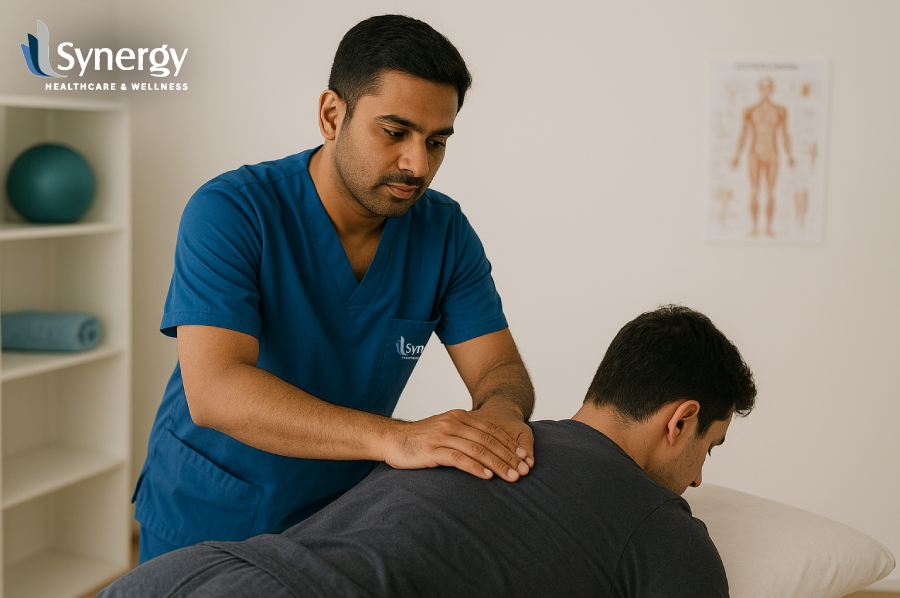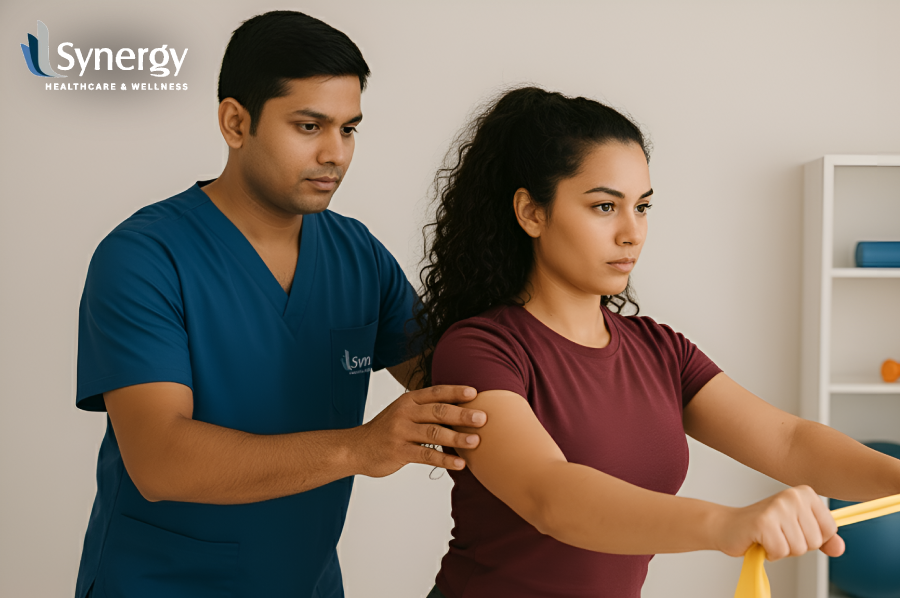The monsoon brings cooler days and a sense of renewal, but it also turns roads, stairs, and tiled floors into hidden hazards. A single misstep on a wet surface can cause the knee to twist violently, leading to an ACL injury that requires careful recovery. In such cases, ACL injury physiotherapy tears becomes the key to regaining movement, strength, and confidence in every step.
Understanding ACL Injuries from Slips in the Rainy Season
The anterior cruciate ligament (ACL) is one of the main stabilising ligaments of the knee. It connects the thigh bone to the shin bone and prevents excessive forward motion of the tibia. When you slip during the monsoon season, your body reacts suddenly, the knee rotates or bends awkwardly, and the ligament may stretch or tear.
Unlike sports injuries, monsoon-related knee ligament injuries often occur in people simply walking on wet stairs or tiles. Such accidents can cause intense pain, immediate swelling, and difficulty bearing weight. In severe cases, the knee gives way even during light movement.
Falls on slick surfaces are particularly dangerous because the impact angle is unpredictable. The combination of poor traction, quick body reflex, and unprepared leg muscles creates the perfect setup for an ACL tear. It is essential to treat this injury promptly through a well-planned ACL injury physiotherapy program.
The Role of Physiotherapy After an ACL Tear
After a slip injury, the knee usually becomes stiff and swollen. Rest alone does not restore its natural stability. That is where ACL rehabilitation through physiotherapy takes over. The goal is to restore motion, rebuild muscle control, and retrain balance mechanisms that protect the joint.
A structured ACL rehabilitation program typically progresses through clear stages:
Early Recovery Phase
The physiotherapist begins with pain management, swelling control, and gentle movement. Techniques such as ice application, compression, and elevation reduce inflammation. Assisted exercises encourage early range of motion without straining the ligament.
Strength and Stability Phase
As pain decreases, attention shifts to muscle strength, especially the quadriceps and hamstrings. These muscles support the knee and compensate for ligament weakness during healing. Controlled strengthening prevents knee instability and helps you regain confidence in walking.
Proprioception and Coordination Phase
Once strength returns, therapy focuses on proprioception training, which means retraining your sense of balance and joint awareness. Exercises on unstable surfaces, step-ups, and single-leg drills help rebuild reflexes that protect the joint from future slips.
Functional Rehabilitation Phase
In the later weeks, therapy prepares you for daily movements, walking on uneven ground, climbing stairs, or returning to sport. The physiotherapist monitors alignment and ensures that both legs move symmetrically before discharge.
A dedicated physiotherapy treatment for an ACL tear can make the difference between long-term weakness and full recovery.
Adapting Rehabilitation to Monsoon Conditions
Recovering from a knee ligament tear during the rainy season requires extra caution. Wet floors increase the risk of re-injury, and humidity can make indoor workouts uncomfortable. A physiotherapist adapts exercises to your environment to maintain safety and consistency.
Indoor Exercise Planning
If outdoor movement is restricted, a home physiotherapy plan for ACL injury can be set up with minimal equipment. Elastic resistance bands, balance cushions, and simple household supports allow you to continue progress indoors.
Surface and Footwear Adjustments
Using footwear with strong grip and cushioning protects the knee during recovery. Rugs, mats, and slippery tiles should be avoided until the joint regains stability. Your therapist may recommend simple changes such as rubber-soled shoes or anti-slip flooring—to reduce risk.
Humidity Management
Monsoon humidity can cause mild joint stiffness. Light warm-up routines, proper hydration, and indoor stretching sessions counter this effect. Physiotherapists often include flexibility drills for the calves and hamstrings to maintain comfort and blood circulation.
Sample Physiotherapy Plan for ACL Recovery
While each case differs, this general guideline outlines what many ACL rehabilitation programs follow:
Weeks 1–2: Healing and Mobility
- Gentle heel slides and ankle pumps to improve circulation
- Quadriceps setting exercises to prevent muscle loss
- Cold therapy to reduce swelling
- Use of a knee brace or crutches if recommended by your doctor
Weeks 3–6: Strength and Control
- ACL rehab exercises such as straight-leg raises, mini squats, and bridge lifts
- Introduction of range-of-motion exercises under therapist supervision
- Core and hip strengthening to support overall balance
- Stationary cycling when knee flexion improves
Months 2–4: Balance and Endurance
- Controlled lunges, step-ups, and single-leg stands for proprioception
- Elastic band resistance exercises for hamstring and quadriceps strength
- Gradual transition to body-weight training and low-impact cardio
Months 4–6: Return to Activity
- Functional drills that simulate real-life movement
- Moderate jogging or sport-specific motion if cleared by your physiotherapist
- Periodic reassessment to ensure complete joint stability
A licensed physiotherapist ensures progression through these stages only when the knee is ready. Trying to rush recovery can lead to new knee instability after an ACL tear or chronic pain.
When to Seek Professional Help
Some patients expect mild knee pain to heal with rest. However, symptoms like locking, repeated swelling, or a feeling that the knee “slips out” signal a deeper issue. You should consult a physiotherapist or orthopaedic specialist if you notice any of these signs after a fall.
A professional evaluation can confirm whether it is a mild sprain or a complete ACL tear. Imaging studies, such as MRI, help determine the extent of the damage. Based on results, the specialist may recommend non-surgical ACL rehabilitation or refer you for surgical reconstruction followed by ACL reconstruction physiotherapy protocol.
Physiotherapists play a vital role even after surgery. They guide you through each milestone—reducing pain, restoring joint mobility, and ensuring a safe return to normal activity. Regular check-ups maintain progress and prevent relapse.
Preventing ACL Injuries During Monsoon
Avoiding another injury is as important as recovering from one. During the rainy season, focus on prevention through awareness and preparation.
Stay Alert on Slippery Surfaces
Be cautious on wet stairs, pavements, and tiled entries. Slow your pace and use railings when available. Avoid sudden turns or jumps when walking in rain gear that restricts movement.
Choose Proper Footwear
Footwear with good traction reduces your risk of slipping. Replace worn-out soles, and clean mud or oil from shoes to maintain grip.
Strengthen and Stretch Regularly
Maintaining strong leg muscles is the best long-term protection for the knee joint. Perform ACL injury prevention exercises like hamstring curls, side-steps, and balance drills at home. Flexibility in the calves and thighs also helps absorb shock during sudden movement.
Improve Body Awareness
Balance exercises on one leg, with eyes closed or on soft surfaces, improve coordination. These simple routines train your body to react quickly if a slip occurs.
Keep Your Surroundings Safe
At home, place absorbent mats near entrances and wipe spills immediately. Proper lighting also helps spot wet areas before stepping on them.
A few mindful habits can keep the knees stable and prevent another ligament tear during future monsoon seasons.
Why Physiotherapy is the Best Recovery Option
A structured ACL physiotherapy program offers complete care—from managing pain to restoring athletic confidence. It focuses not only on healing the ligament but also on improving body mechanics to avoid future injuries. Through guided sessions, the knee regains stability, strength, and flexibility, allowing you to return to routine without fear.
The process may seem gradual, yet each week brings tangible improvement. Walking becomes smoother, swelling subsides, and the leg feels more reliable. By the end of a proper ACL rehabilitation timeline, most patients achieve normal motion without lingering weakness.
Key Takeaways
- Monsoon slips often cause ACL injuries due to sudden twisting and loss of traction.
- Physiotherapy for ACL tear helps restore movement, rebuild strength, and retrain balance.
- Indoor rehabilitation, safe footwear, and gradual progress protect recovery during rainy months.
- Seek early medical help if pain, swelling, or instability persists.
- Consistent home exercises and follow-ups ensure full return to function and reduce future risk.
Every Step Toward Recovery Is Important
At Synergy Physiotherapy, we believe in restoring movement through knowledge, skill, and genuine care. Our team of senior physiotherapists and rehabilitation experts work together to design personalised treatment plans that address the root cause of pain and limitation. We combine clinical precision with compassionate support, guiding every patient toward long-term recovery and renewed confidence in their body. With centres in Anna Nagar, T. Nagar, and Adyar, we make expert physiotherapy accessible across Chennai. We take pride in being partners in your journey to strength, balance, and well-being.
Conclusion
An ACL injury caused by a monsoon slip can disrupt daily life, but recovery is entirely possible with patient-specific physiotherapy treatment. Each session rebuilds coordination and confidence step by step. With steady effort and expert guidance, the knee regains its natural rhythm, ready to move freely again—even when the rain returns.
FAQ’s
1. What happens to the knee during an ACL injury caused by a slip?
When you slip on a wet surface, the leg may twist suddenly while the foot remains fixed. This abrupt motion can stretch or tear the anterior cruciate ligament (ACL), which supports knee stability. The injury often results in swelling, pain, and difficulty walking.
2. How does physiotherapy help after an ACL tear?
Physiotherapy for ACL injury focuses on reducing pain, restoring movement, and rebuilding strength. Through guided exercises, it helps the muscles around the knee especially the quadriceps and hamstrings to support the joint. Consistent therapy shortens recovery time and prevents long-term instability.
3. Can an ACL tear heal without surgery?
A partial ACL tear can sometimes recover with non-surgical ACL rehabilitation if the knee remains stable. Complete tears often need surgical repair, followed by a structured ACL reconstruction physiotherapy protocol. Only a medical professional can decide the right approach based on the extent of damage.
4. How long does ACL physiotherapy take after a monsoon slip?
Recovery duration depends on injury severity and commitment to therapy. Mild cases may recover in three to four months with regular sessions. Post-surgical ACL rehabilitation may take six months or longer for full function and return to activity.
5. What are the best exercises for ACL rehabilitation at home?
Some safe ACL rehab exercises include straight-leg raises, heel slides, side-lying leg lifts, and mini squats. As healing progresses, balance drills and resistance band workouts improve stability. Always follow a physiotherapist’s instructions to avoid strain.

